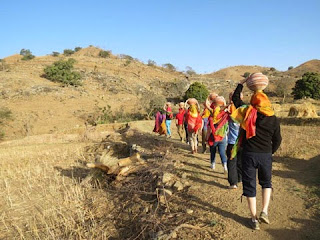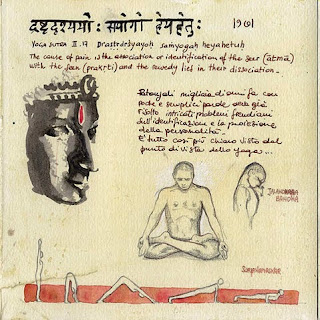We had been invited to go
on a three-day excursion, in which we visited some rural villages to
apply what we'd learnt on the course. And that experience was
mind-blowing, to say the least. Our itinerary was pretty charged: on
the first day, we would go to Barind. Then, on the second one we
would visit Lai Gow. Finally, we would spend the last day in Udaipur.

Barind is a small and
remote rural village located in an isolated region of Rajsamand
district. When we arrived at 6 am, we were received by the locals
with laughs, cheers and sincere “Namastes”. We were surprised by
the extraordinary number of children who were celebrating our
arrival. Our mission there was to build a school for the kids since
the one they had was crumbling apart and couldn't hold the large
number of children in the community. The thing I first noticed was
the poverty all around me. However, everyone seemed so happy. Before
we got to work, we assisted to a Puja prayer ceremony. We were told
that every new build project begins with a traditional ceremony to
ensure its success and prosperity. It's intended to bless the site,
the tools, the workers, and the future students and teachers. The
ceremony was conducted in Sanskrit, one of the world's oldest
languages. It was really interesting to assist to it and to learn
more about the Hindu traditions. At lunch time we were almost
finished with the project, so we were allowed to interact with the
kids and play games with them. The language wasn't a barrier at all.
We were a novelty to them, and they were all grinning ear-to-ear.
Their reactions when they saw the finished building were priceless.
No one ever did something like that for them, which made me realize
that the simple things we do have a huge impact on another person's
life. We also discussed about the gender roles issue: Most of the
village girls have to stay at home in order to help with the chores,
while the mothers have to go to a nearby village to work. This
affects their ability to get a proper education and work outside the
home. It happens as well with some families who are forced to keep
their kids out of school to work and earn money for their families.
At the end of the day we had to leave, and it broke my heart to leave
these kids, but I was relieved by the fact that we would return the
following week to work on a goat-rearing project, so the local women
are able to earn a sustainable income to support their families.
 |
| The Puja prayer ceremony |
 |
| A picture of us building the school! |
We arrived to Lai Gow the
following day, at dawn. It's another rural village, with
infrastructures similar to Barind's, but with a bigger problem: the
locals don't have access to clean water, due to drought and changing
climate patterns. The nearest water sources are contaminated rivers,
leaving people vulnerable to some deadly diseases, especially
children. We worked alongside Lai Gow community members to help build
hand-washing stations with potable water and to dig a well. But
first, we had to immerse in the day-to-day life of the locals. We
went for a water walk with the mothers and daughters in the
community. I can safely say it was the most profound moment on the
trip until now. In order to get water, women have to walk multiple
times a day 3km to the nearest river with pots, fill them with
contaminated water, and return to the village. It was an amazing
experience carrying the pots and getting a different perspective of
life. It made me take a step back and realize how different some
people lived. Back in home, I just need to turn the tap on to get
clean, hot or cold water. It takes a second. And what's worse, we
waste it. It could save lives in Lai Gow. In the afternoon, we took a
nature walk by the fields and planted some trees. The views were
breath-taking. Afterwards, the women of the village taught us how to
make roti, a traditional Indian bread, and samosas, which are
triangular pastries filled with spiced with spiced potatoes, onion,
peas and meat. It was delicious, and quite easy to make. I'll sure be
doing these things at home!
The nature walk: what a view!
Making roti with the village women
The best moment: The water walk

The last day was quite
relaxing. We didn't have any building projects, so we visited some
historical sites and went sight-seeing around Udaipur. We spent our
morning touring the stunning Ranakpur Temple, part of the Top 77
Wonders of the World list, which doesn't surprise me at all. It's
known for its intricate and superb architecture. It was built in the
15th century and was dedicated to Lord Adinath, who was
the first “Tirthankara” (in Sanskrit, “Ford-maker”) of the
Jain ancient religion. It's truly majestic. Afterwards, we went to
the city of Udaipur, where we visited the old city market. I got to
buy many souvenirs for my family and friends, and I also got a henna
tattoo, which I love! The instructors then had a surprise for us, to
reward us for all the hard work we put into the projects. And it
turned out to be a Bollywood dancing lesson! I had lots of fun and
got to know my peers better. I felt like an Hindu princess in a
movie. The music was also quite catchy!
The Ranakpur Temple
Bollywood dancing
Udaipur's city market
My henna tattoo!












